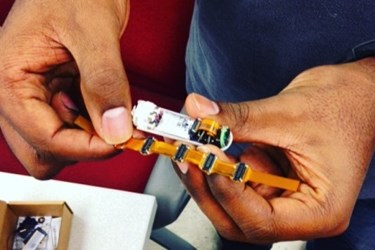Vanderbilt Open Sources Robotic Pill Technology To Jump-Start Research

Vanderbilt University scientists have been developing robotic capsules that are small enough to swallow, and now they want to share their research with the world. With open-sourced hardware and software development kits available online, researchers will be able to build upon Vanderbilt’s existing technology to develop prototypes for new indications that will improve diagnostic and therapeutic medicine.
Ingestible electronics have the potential to assist in drug delivery, biopsy, medical imaging, and surgical applications. A few digital capsule devices — such as PillCam and Philips’ Itellicap — are already in clinical use, but these are propelled by the body itself and cannot be influenced by clinicians. Vanderbilt’s research allows doctors some control of the device once it enters the body.
The director of Vanderbilt’s Science and Technology of Robotics in Medicine (STORM) Lab, Pietro Valdastri, and his team have designed robotic capsules capable of taking images of the colon or delivering a surgical clip to stop internal bleeding in the gastrointestinal tract. As the team developed capsules for new indications, Valdastri noted in a press release that they were re-using some of the same components — microprocessors, energy sources, actuators, and sensors — in each design.
Miniaturizing electronics that can be safely ingested by the human body requires a specific expertise that can take years to develop and perfect, and innovation is slowed down when research teams are forced to “reinvent the wheel.” By open-sourcing the different components of their existing technology, Valdastri and his team hope to give researchers worldwide a helping hand.
“Like it is with Lego bricks, you can reassemble [the components] for different functions,” said Valdastri. “We wanted to provide the people working in this field with their own Lego bricks for their own capsules.”
The team’s research — presented at two Institute of Electrical and Electronics Engineers (IEEE) conferences and published in IEEE Design & Test magazine — is now displayed on a website called PillForge. While the modules are too large for practical use in a clinical setting, the open-sourced information allows scientists to test different hypotheses for proposed indications. Once a team establishes proof-of-concept, they can move on to developing their own custom capsule.
In addition to hardware components, the website also gives an overview of flexible software solutions that pair well with the technology and interface easily with existing research.
“Our focus is the design environment, not the software per se, with the goal of easing the learning curve for new researchers and engineers who start in this field,” said Akos Ledeczi, senior research scientist at Vanderbilt’s Institute for Software Integrated Systems.
Valdastri told IEEE Spectrum that his research was made possible by the National Science Foundation, and it was “in the spirit of the grant proposal” to make it accessible to the global research community. He added that research teams from Hong Kong, Scotland, and South Korea have all expressed interest in using the Vanderbilt system to further their research.
In September, the FDA accepted a New Drug Application (NDA) for Otsuka Pharmaceutical’s Abilify, which is embedded with sensors designed by Proteus Digital Health. If Abilify is approved, it will be the first digital medication cleared in the U.S. for clinical use.
According to Carnegie Mellon University researcher Christopher Bettinger, this type of technology —part of a growing wave of ingestible devices — has the potential to make healthcare more efficient and cost-effective.
